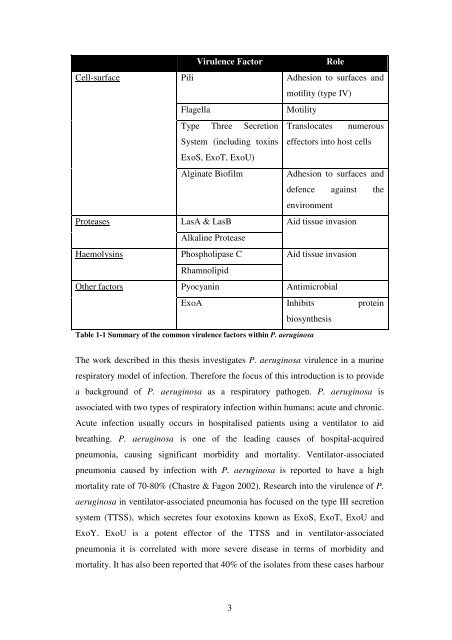5 The role of quorum-sensing in the virulence of Pseudomonas ...
5 The role of quorum-sensing in the virulence of Pseudomonas ...
5 The role of quorum-sensing in the virulence of Pseudomonas ...
Create successful ePaper yourself
Turn your PDF publications into a flip-book with our unique Google optimized e-Paper software.
Cell-surface<br />
Proteases<br />
Haemolys<strong>in</strong>s<br />
O<strong>the</strong>r factors<br />
Virulence Factor Role<br />
Pili Adhesion to surfaces and<br />
Flagella Motility<br />
Type Three Secretion<br />
System (<strong>in</strong>clud<strong>in</strong>g tox<strong>in</strong>s<br />
ExoS, ExoT, ExoU)<br />
3<br />
motility (type IV)<br />
Translocates numerous<br />
effectors <strong>in</strong>to host cells<br />
Alg<strong>in</strong>ate Bi<strong>of</strong>ilm Adhesion to surfaces and<br />
LasA & LasB<br />
Alkal<strong>in</strong>e Protease<br />
Phospholipase C<br />
Rhamnolipid<br />
defence aga<strong>in</strong>st <strong>the</strong><br />
environment<br />
Aid tissue <strong>in</strong>vasion<br />
Aid tissue <strong>in</strong>vasion<br />
Pyocyan<strong>in</strong> Antimicrobial<br />
ExoA Inhibits prote<strong>in</strong><br />
biosyn<strong>the</strong>sis<br />
Table 1-1 Summary <strong>of</strong> <strong>the</strong> common <strong>virulence</strong> factors with<strong>in</strong> P. aerug<strong>in</strong>osa<br />
<strong>The</strong> work described <strong>in</strong> this <strong>the</strong>sis <strong>in</strong>vestigates P. aerug<strong>in</strong>osa <strong>virulence</strong> <strong>in</strong> a mur<strong>in</strong>e<br />
respiratory model <strong>of</strong> <strong>in</strong>fection. <strong>The</strong>refore <strong>the</strong> focus <strong>of</strong> this <strong>in</strong>troduction is to provide<br />
a background <strong>of</strong> P. aerug<strong>in</strong>osa as a respiratory pathogen. P. aerug<strong>in</strong>osa is<br />
associated with two types <strong>of</strong> respiratory <strong>in</strong>fection with<strong>in</strong> humans; acute and chronic.<br />
Acute <strong>in</strong>fection usually occurs <strong>in</strong> hospitalised patients us<strong>in</strong>g a ventilator to aid<br />
breath<strong>in</strong>g. P. aerug<strong>in</strong>osa is one <strong>of</strong> <strong>the</strong> lead<strong>in</strong>g causes <strong>of</strong> hospital-acquired<br />
pneumonia, caus<strong>in</strong>g significant morbidity and mortality. Ventilator-associated<br />
pneumonia caused by <strong>in</strong>fection with P. aerug<strong>in</strong>osa is reported to have a high<br />
mortality rate <strong>of</strong> 70-80% (Chastre & Fagon 2002). Research <strong>in</strong>to <strong>the</strong> <strong>virulence</strong> <strong>of</strong> P.<br />
aerug<strong>in</strong>osa <strong>in</strong> ventilator-associated pneumonia has focused on <strong>the</strong> type III secretion<br />
system (TTSS), which secretes four exotox<strong>in</strong>s known as ExoS, ExoT, ExoU and<br />
ExoY. ExoU is a potent effector <strong>of</strong> <strong>the</strong> TTSS and <strong>in</strong> ventilator-associated<br />
pneumonia it is correlated with more severe disease <strong>in</strong> terms <strong>of</strong> morbidity and<br />
mortality. It has also been reported that 40% <strong>of</strong> <strong>the</strong> isolates from <strong>the</strong>se cases harbour














